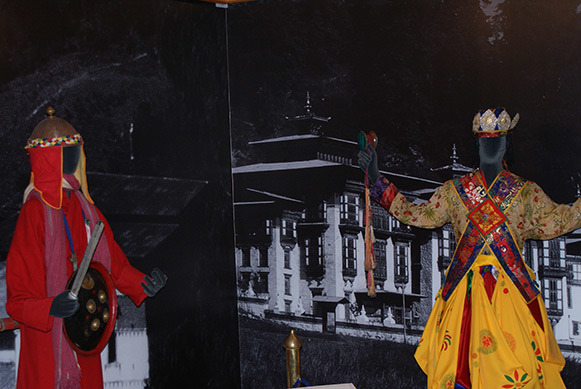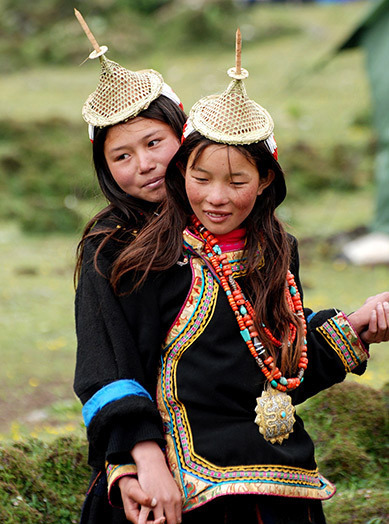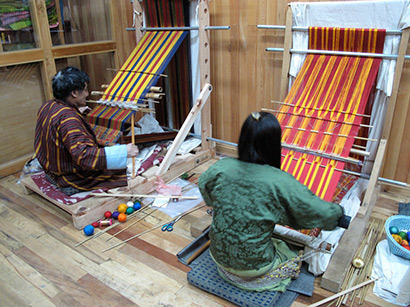WEAVING IN PRESENT BHUTAN
In modern day Bhutan, one can still find three types of looms being used - pangtha, thritha, and soghu thagshing. It is believed that thritha was introduced in Bhutan by the Thimphu zimpon Rinchen Dorji from Tibet. Bhutanese weaving can be split into two categories: Tsongtham - Cloth woven for commercial purposes, and Hingtham - Cloth woven for relatives and friends. Hingtham, or ‘heart-woven’, also depicts the social and spiritual significance of weaving in Bhutan. The kingdom is renowned for its silk-on-silk textiles that carry sophisticated, embroidery-like patterns. The technical skills of Bhutanese weaving are taught through six-year courses at The Royal Thimphu College and Royal Textile Academy of Bhutan, both located in the capital, Thimphu.
Interesting Fact: Although the knowledge of the Bhutanese traditional patterns has been passed from one generation to another only orally & there are no written records, yet most of the ancient motifs are still in vogue. Time has definitely taken its toll & some of the motifs are not as common as they used to be. In fact few motifs are very difficult to locate & these designs can now only be seen in the museums.
TRADITIONAL DRESSES FOR MEN & WOMEN IN BHUTAN
The traditional dress for men is Gho and for women is Kira. These beautifully woven dresses are the official dresses in Bhutan. Introduced in 17th century by Zhabdrung Ngawang Namgyel, these dresses do preserve & promote the cultural heritage of Bhutan which was exactly why they were envisioned. All Bhutanese are required to wear the national dress in government offices, schools and at all formal occasions.
Gho is a long robe hoisted to the knee and held in place with a kera, a woven cloth belt, wound tightly around the waist. This forms a large pouch that may be used to contain particular items, traditionally a bowl and betel nut.
Kira is a floor-length rectangular piece of cloth wrapped around the body over a blouse called wonju. The kira is held from the shoulders by broach-like hooks called koma and is fastened at the waist with a kera (belt). The dress is complete with a short, open jacket-like garment called toego.
PLACES TO SEE THE BEST OF WEAVING IN BHUTAN
Traditionally limited to Eastern Bhutan, weaving has spread to all parts of the country today. It is believed that weaving developed in the eastern part of the kingdom because of the rugged physical terrain and limited cultivable land. On the other hand, there is a lot of cultivable land in western Bhutan. So the people in these areas had big farming lands and had no time to dedicate for weaving.
The people of Bhutan take pride in creating these amazing and unique textiles. Almost every Bhutanese house has some connection to weaving. The art of weaving in Bhutan is so unique that one cannot find it anywhere outside Bhutan.
BHUTAN TEXTILE MUSEUM, THIMPU

With exhibits based on six major themes - warp pattern weaves, weft pattern weaves, role of textiles in religion, achievements in textile arts, textiles from indigenous fibers and the royal collection, Bhutan textile museum gives you a glimpse of the art of weaving in Bhutan.
In the museum, one will also be able to see the crowns of Bhutanese Kings, namzas (dresses), the first version of royal crown and other accessories used by members of Royal family.
CHUMEY VALLEY
Chumey, one of the four valleys of Bumthang, is known for Yathra weaving. Yathra is a hand-woven fabric which is made from wool of yak and sheep. The woollen clothes, bags, scarfs etc. in vibrant colors & unique patterns are the speciality of this weaving. A visit to a Yathra weaving centre will give one an insight into the technique of this form of weaving.
LHUENTSE

Khoma village near Lhuentse is famous for the production of high-quality hand woven silk textile called Kishuthara. It is a silk weaving technique with intricate hand laced patterns.
Most celebrated & expensive textile in Bhutan, Kishuthara is generally worn only on special occasions and is one of the most sought after textile by collectors. On a visit to this village one can have the opportunity to see the technique & try the hand at weaving as well.
Insider Tip: For the real keener & who are ready to walk, we recommend a visit to Gonpa Karpo, which is a four hours walk from Khoma village. This remote village is clustered around a sacred monastery & the weavers here have a feeling that their weaving is superior because of the special blessing from the deities of this sacred site.
RADHI VILLAGE

Radhi is famous for fine raw silk, known as ‘bura’. The villagers use traditional weaving & dyeing techniques to produce famous textiles. On a visit to this village, one may also spot Brokpas, semi-nomadic yak herders from nearby Merak and Sakteng, who come here to barter their Yak butter, cheese, and dried meat with other food commodities.
KHALING
Here visit the weaving center which is operated by the National Women’s Association of Bhutan. This institute is a pioneer in preserving the weaving culture in Bhutan. Here one can see the girls weaving different types of textiles on a back strap loom. For the enthusiasts a visit can also be arranged to the house of a private weaver to see the techniques of Bhutanese dye.
Bhutanese are proud of their artistic heritage and the craftsmen here consider creating arts and crafts as pious acts, thus gaining merit for the patron. On a tour to Bhutan with us, one can learn how the weaving masters work as they will also explain the minute details of these patterns. We, at Indo Asia Tours, are all about the handcrafted tours, memories, and moments you take out of your trip, and believe us, this escapade will be a life-changing one!



 With exhibits based on six major themes - warp pattern weaves, weft pattern weaves, role of textiles in religion, achievements in textile arts, textiles from indigenous fibers and the royal collection, Bhutan textile museum gives you a glimpse of the art of weaving in Bhutan.
With exhibits based on six major themes - warp pattern weaves, weft pattern weaves, role of textiles in religion, achievements in textile arts, textiles from indigenous fibers and the royal collection, Bhutan textile museum gives you a glimpse of the art of weaving in Bhutan.
 Khoma village near Lhuentse is famous for the production of high-quality hand woven silk textile called Kishuthara. It is a silk weaving technique with intricate hand laced patterns.
Khoma village near Lhuentse is famous for the production of high-quality hand woven silk textile called Kishuthara. It is a silk weaving technique with intricate hand laced patterns.
 Radhi is famous for fine raw silk, known as ‘bura’. The villagers use traditional weaving & dyeing techniques to produce famous textiles. On a visit to this village, one may also spot Brokpas, semi-nomadic yak herders from nearby Merak and Sakteng, who come here to barter their Yak butter, cheese, and dried meat with other food commodities.
Radhi is famous for fine raw silk, known as ‘bura’. The villagers use traditional weaving & dyeing techniques to produce famous textiles. On a visit to this village, one may also spot Brokpas, semi-nomadic yak herders from nearby Merak and Sakteng, who come here to barter their Yak butter, cheese, and dried meat with other food commodities.
 Thank you, patrons, for reposing faith in our destinations and enquiring for customised virtual destination awareness training programs. We are proud to conduct them successfully so far and are looking forward to hold similar virtual destination awareness training programs for your team or yourself or a virtual tour for your clients. Let us know the destination of your interest along with your convenient date / time and we will be happy to set up a program for you.
Thank you, patrons, for reposing faith in our destinations and enquiring for customised virtual destination awareness training programs. We are proud to conduct them successfully so far and are looking forward to hold similar virtual destination awareness training programs for your team or yourself or a virtual tour for your clients. Let us know the destination of your interest along with your convenient date / time and we will be happy to set up a program for you.


